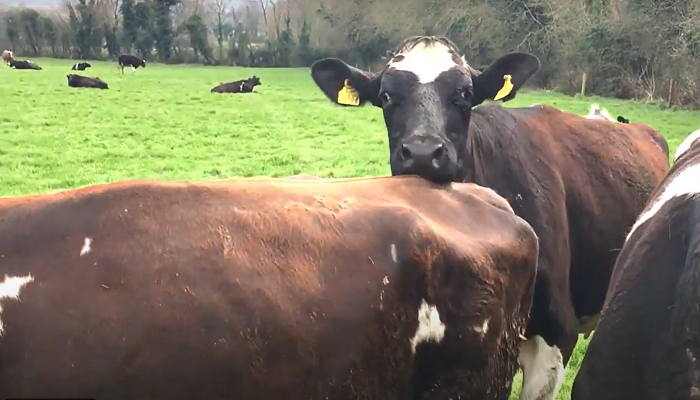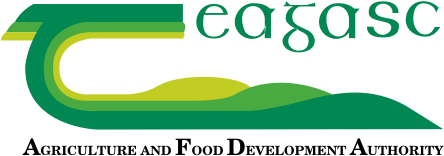Heat activity in pasture based dairy cows

During the recent Teagasc/ICBF breeding week three key reproductive targets were identified as being critically important in seasonal calving dairy herds. George Ramsbottom, Dairy Specialist has details, plus breeding guidelines for spring 2021 and advice on managing late calving dairy cows here
Key reproductive targets
- A 90% 6-week calving rate;
- A 365 day calving interval;
- A planned empty rate of less than 8% at the end of a 12 week breeding season
While all of the video releases, podcasts and supporting material is available on the Teagasc and ICBF websites, seehere, a sample of some of the content delivered is presented in this article.
Heat activity at grass
Fundamental to achieving the reproductive targets outlined above is efficient heat detection. A missed heat can cost almost €150 when it occurs during a 12 week breeding season. Failure to correctly identify cows in heat and inseminating them at the incorrect time are major limitations to achieving excellent reproductive performance.
Research conducted by Stephen Moore and colleagues at Mooreparkhas recently been published summarising the heat activity of dairy cows at pasture. On average increased activity associated with heat lasted for 17.2 hours while mounting activity lasted for an average of 8.7 hours. However there was considerable variation between cows in the duration of both heat activity and standing heat as shown in Figure 1.

Figure 1:Frequency distribution of duration of heat activity (top graph) and duration of standing heat (bottom graph).
The most important message coming from the study was that the duration of standing heat was for less than 8 hours in 55% of the cows. The implication of this finding is that the use of heat detection aids is absolutely critical to achieving a high heat detection rate. Old research from the 1990’s supports this finding in that compared to three times daily heat detection, the use of an aid increased heat detection rate by 20%.
Stephen said that a variety of heat detection aids are available for use on dairy cows and maiden heifers. When used correctly, all are effective at increasing heat detection rate.
- Tail paint should be applied as a narrow strip (50mm wide and 200mm long) and topped up at least once weekly. The biggest mistake that’s made with it is that it’s not topped up regularly enough.
- Scratch cards are well proven particularly with maiden heifers. Cards can be lost if excess winter hair at the tail head is not removed before sticking them on.
- Electronic activity monitors can be used to maintain the efficiency while reducing the labour required in heat detection.
Irrespective of the aids used, Stephen recommended that farmers should begin heat detection three to four weeks before breeding actually begins to establish which cows are cycling and which will require further intervention.
Breeding guidelines for spring 2021
Andrew Cromie, ICBFdetailed the guidelines that have been developed by a DAFM-led dairy calf welfare working group, consisting of key industry stakeholders.
- Know your herd’s strengths and weaknesses. Refer to yourICBF Herd EBI Scorecardto help establish what these are.
- Select a team of high EBI AI bullswhen breeding your dairy herd replacements. For a typical 100 cow dairy herd, a minimum of 8 bulls should be used on your herd, with no more than 15% mating’s to any one bull.
- Target high EBI females(通常是少女小母牛,第一和第二弗s) to breed your next generation of dairy herd replacements. Lower EBI cows should be bred to beef AI from the start of the breeding season.
- Use the Dairy Beef Index to select suitable beef AI siresfor your dairy herd. A team of bulls should be selected that suits the various dams in your herd (i.e., maiden heifers, young cows and mature cows) and the number of these that are selected for beef AI. Bulls with higher beef merit figures should be selected for older animals. Consider the use of vasectomised bulls in conjunction with beef AI as an alternative to beef stock bulls. Avoid using dairy ‘sweeper’ bulls.
- Use the ICBF HerdPlus Sire Advice Toolto help manage your breeding program and simplify the process of sire selection. It will allocate your bulls to cows based on their strengths and weaknesses, as well as manage inbreeding. Cows designated for beef AI should be flagged to ensure that only the best animals are used to breed dairy herd replacements. For more information on this tool please speak to ICBF HerdPlus, your Teagasc Advisor and/or your AI company.
- If using sexed semen, only use high EBI siresand ensure that all sexed semen inseminations occur early in the breeding season. Any inseminations with Jersey or crossbred bulls should be conducted using sexed semen only. Pay careful attention to straw handling and AI procedures, as sexed semen contain fewer sperm, and these sperm are more fragile after the sorting process.
Managing late calving cows
Stuart Childs, Teagasc Dairy Specialist, addressed the issue of managing late calving cows. On average almost 390,000 dairy cows (or more than one quarter of spring calving Irish dairy cows) calved after April 1stin 2019 and 2020 with almost as many calving in May and June as in April. Because the reproductive cycle of the cow requires a period of rest and recovery after calving before she can go back in calf again, she requires a rest period of approximately 30 days after calving before commencing a treatment programme. Cows calving within four weeks of the start of the breeding season warrant special attention to help ensure that they go back in calf. Stuart detailed two approaches that can be taken to shorten the interval between calving and breeding in such cows.
The Once A Day milking approach
This approach is typically used on low SCC, late calving or thin (BCS <2.5) cows. It works on the principle that once a day milking reverses the trend towards body condition loss in early lactation because of the reduced milk yield (typically 30% lower volume) compared to cows milked twice daily. Milking them once a day from calving speeds up the resumption of their reproductive cycle and such cows also have a higher conception rate to first service. Using the once a day milking approach, cows are typically AI’d within 50 days of calving. The loss in milk yield for a cow milked once a day for 40 to 60 days is approximately €55-75. Speaking at one of the breeding week webinars, Kerry dairy farmer William Dennehy strongly advocated this approach saying that he uses it every year on the few cows that calve on his farm after the first of April.
The hormonal intervention approach
Stephen Butler at Teagasc Moorepark看着佑天兰ty of hormonal treatments to induce heat in cows that are calved 30 days or more but not cycling. The advantage of the hormonal treatment programme is that it promotes cyclicity in cows that are not yet naturally cyclic (however they should be 30 or more days calved at the start of the synchronisation treatment) and that they can be AI’d at a fixed time regardless of the signs of heat. Careful adherence to the times of administering the prostaglandin and GnRH injections and artificial insemination at the end of the protocol are absolutely critical to its success. Using this approach late calving cows are typically batched into groups and AI’d at an average of 45 days after calving. The treatment cost is approximately €40 per cow excluding AI cost.
For more information see all content fromTeagasc/ICBF breeding week here
